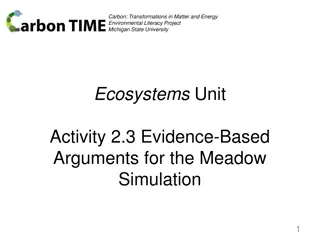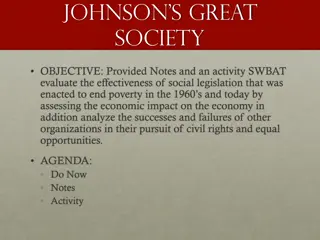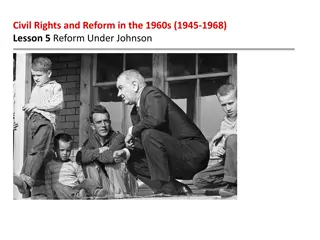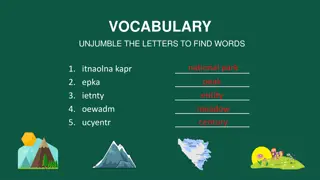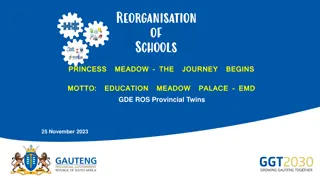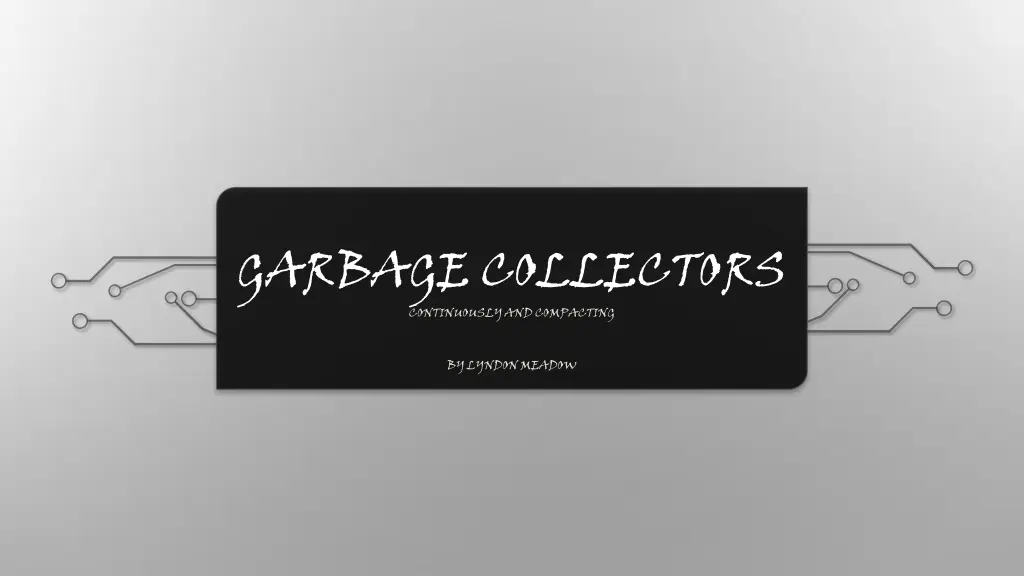
Understanding Garbage Collection Models and Solutions
Learn about the importance of Garbage Collectors, different Collector Models, and solutions like Continuous Compacting and Concurrent Collections for optimal memory management in software development.
Uploaded on | 0 Views
Download Presentation

Please find below an Image/Link to download the presentation.
The content on the website is provided AS IS for your information and personal use only. It may not be sold, licensed, or shared on other websites without obtaining consent from the author. If you encounter any issues during the download, it is possible that the publisher has removed the file from their server.
You are allowed to download the files provided on this website for personal or commercial use, subject to the condition that they are used lawfully. All files are the property of their respective owners.
The content on the website is provided AS IS for your information and personal use only. It may not be sold, licensed, or shared on other websites without obtaining consent from the author.
E N D
Presentation Transcript
GARBAGE COLLECTORS CONTINUOUSLY AND COMPACTING BY LYNDON MEADOW
Why do we want Garbage Collectors (GCs)? What is a Garbage Collector (GC)? What are our Basic Collector Models? Our Unique and Modern Problem Solution: Continuously Compacting Real-Time GCs What is means to be Stopless? Bring me my CoCo Playing Chicken Picking Clovers Endgame of Modern GCs PRESENTATION CONTENTS
WHY DO WE WANT GARBAGE COLLECTION (GCS)? Primarily we want reliable and secure software that is quick an cheap to develop. Specifically we want the rapid development of applications with: High Responsiveness Meeting Short Deadlines
WHAT IS A GARBAGE COLLECTOR (GC)? Objects may be freely created, in object oriented languages. We d like someway to keep track: Such as a root set of pointers Must detect when object is no longer referenced by the program. Garbage Objects that are no longer accessible and hence need collection to free memory and avoid overflows.
WHAT IS A JUST A COMPACTING SOLUTION? We want a continuous space in memory for optimal new object creation. Dead objects are deleted, and then all living objects made into a continuous region on the heap. First Pass Marks Dead Objects Further Passes Calculate/Move/Update Live Object References Handle Pools might be used as method of pointer consolidation. But subsequently adds a level of indirection to each object access Stop the World Collector pauses program execution as GC runs
COMPACT ING GC MODEL
WHAT IS A JUST A CONCURRENT SOLUTION? We want to avoid execution delays from GC operation Useful when can only use limited resources/ time Useful when system has a spare CPU thread to dedicate Solving problem of a partially collected heap in a state of flux Uses a form a synchronization to avoid referencing marked objects Write Barriers are standard choice for protection Check for when a pointer in an already marked object is overwritten On occurrence, remark object and put it back in object queue But memory isn t defragmented!
CONCURR ENT GC MODEL
OUR UNIQUE AND MODERN PROBLEM Desire both a system that collects dead objects without significant delays. And a system that makes the heap continuous for the creation of new live objects. Specifically for modern multithreaded applications, that must operate in real time.
SOLUTION: CONTINUOUSLY COMPACTING REAL-TIME GCS I.E. STOPLESS On-the-fly lock-free mark sweep collector, which reclaims dead objects concurrently Concurrent (Partial) Compaction mechanism that supports said parallel and lock-free multithreaded applications Additionally consider barrier costs in further optimizations as well as those by alternative Stopless implementations
BASICS OF STOPLESS GCS: LOCK FREE Will some thread complete an operation after the system has run a finite number of steps? Yes, by extension of typical single-thread requirements. A thread is required to complete an operation after some constant steps.
BASICS OF STOPLESS GCS: REAL TIME In the strictest terms: Robustness to worst case almost zero probability events such as: Worst case memory fragmentations Unassured collector terminations Etc Stopless is soft real time, in other words we let entropy into our system for hopeful performance gains in most usage cases. Worst case, the program fails in the middle of operation and hits bare metal.
BASICS OF STOPLESS: CONCURRENT COMPACTION Most solutions to shifting threads and multiple copies of an object may usually be tolerated in most memory coherence models. However, this isn t the case for Real Time which require atomic operations. Creating ordering constraints that don t allow much reordering. CoCo system is first practical realization of these goals.
GUIDE Stopless- Stock model STW Stop the World CPP Manual C++ memory management
BRINGING THE COCO Moves objects in the heap concurrently with program executions Allows parallel threads coordinated via atomic operations on shared memory Supporting program semantics/ lock-freedom guarantees. Satisfies Linearizability and Sequential Consistency memory models. Basically, uses a wide object to transition from the original object to the copied object.
WIDE OBJECT MODEL
SOLUTION IS FOUND, THE PROBLEMS CONTINUE We have achieved up to this point faster responsiveness for real time systems that require deadlines at the microseconds level. Even have obtained powerful scalability for larger programs. But, is it possible to reduce time even further? Below the newfound average of 10 micro seconds? What may be adjusted in the compaction algorithm?
WHAT DOES FAILURE MEAN? With the Stopless implementation we already have accepted some soft balling of real time requirements. We ignore problems that always can happen such as a hardware failure, memory corruption, page-faults, software-bugs, or even just odd cache behaviors. Not known what distribution space is, so relaxed attituded is justified.
PLAYING CHICKEN Assumes that a race between the Program and the GC won t occur. Will at some cost, gracefully abort a move if such a conflict occurs. Maintains the invariant that all threads agree on if an object is copied or not. Maintains the invariant that all threads always use the correct object to load and store values.
BENEFITS OF BEING A CHICKEN Objects are copied as a whole Lets all program threads switch to new location Avoids sluggish per-field read checks that Stopless and Clover use. Writing is a wait-free operation If fully copied then write to to-space If not tagged for copying then write to from-space Else Chicken must Abort using compare and swap
BENEFITS OF BEING A CHICKEN CONTINUED Soft-Handshake occurs before copying starts Each object that is meant to be copied is tagged first Waits until all threads acknowledge the compaction phase The copying process is wait-free Objects are flipped from from-space to to-space individually. If a program writes to an object before flipped, tag cleared, object not copied. If flipped, object is copied, then program threads read/write to-space.
PICKING CLOVERS Doesn t block data races between collector and program threads If a value v is chosen from a space of 2^l values V Then probability of being stored any given store execution is 2^-l If forbidden value is written to, opened locks need to be re-locked.
BENEFITS OF PICKING CLOVERS Just like Chicken the simpler implementation reduces complexity Allocated a random alpha to a single space in the heap, which probably won t get overwritten. Odds of failure are essentially impossible on most modern 64 bit architectures Similar to both Chicken and Stopless, soft-handshakes also used.
STOPLESS/CHICKEN/CLOVER Heap Access 1. Chicken: all heap access are wait free, except on compare swaps which are still lock free. 2. Clover: Heap write might get stalled until compaction completes 3. Stopless: Provides Lock Free writes, Branches for reads
STOPLESS/CHICKEN/CLOVER Aborting 1. Chicken: Aborts eagerly since has strictest requirments 2. Clover: Never aborts unless user requests it 3. Stopless: Aborts when multiple mutator threads write into same field simultaneously as compaction occurs.
STOPLESS/CHICKEN/CLOVER Termination 1. Chicken: Guaranteed to complete, but may not copy all objects 2. Clover: Doesn t have a guarantee, but can be modified to include it 3. Stopless: Never guarantees termination
DISTRIBUTI ONS OF TRANSACT ION TIMES
ENDGAME OF MODERN GCS Several Implementations that crushed IBM s Java Collector as of 2008. Several new implementations and further research still being conducted. Notably C4 introduced generational aspect to this process. Near native binary efficiency and response times, approaching.

